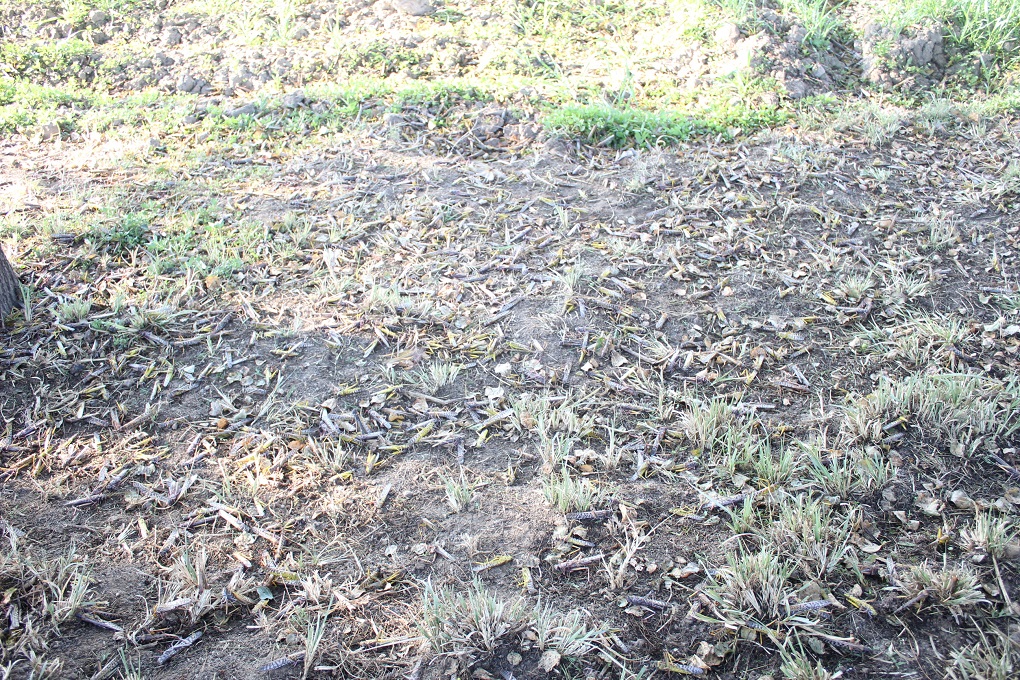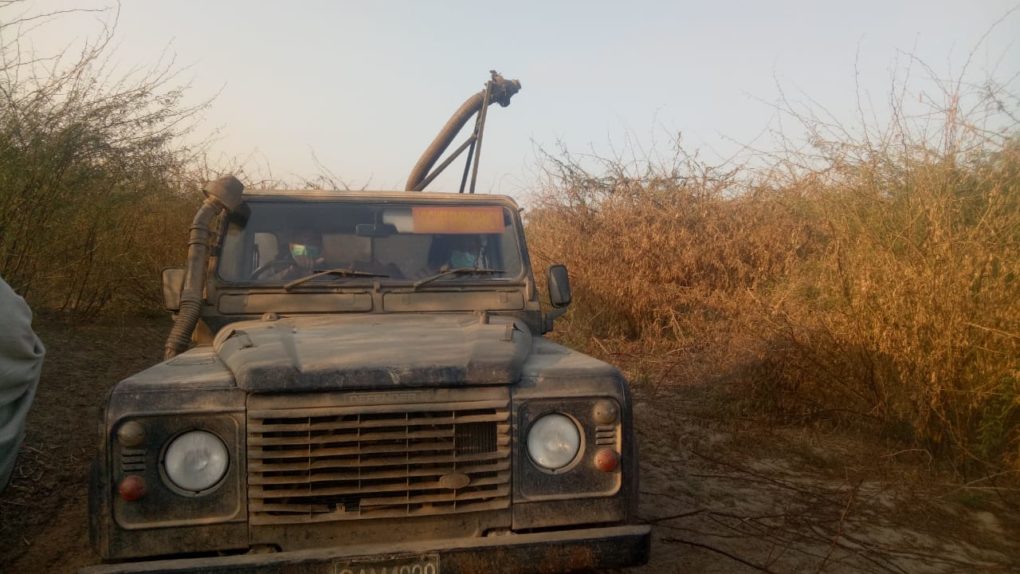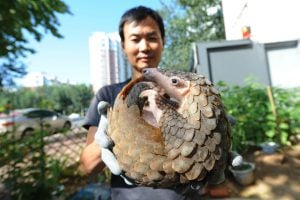For more than 60 years, even when the crop was good, farmers in the southern Dera Ismail Khan district of Pakistan’s Khyber Pakhtunkhwa province would caution each other against the forces of nature, all the while remaining grateful that their yield was not affected. They were mostly alluding to locusts, which had some six decades back descended on the region and devoured every last vestige of greenery. The infestation was so horrific that it became etched into the collective memory of local farmers as an aphorism. “Tidi ayi ta jithan sabza ty bhendi hai bohari chorendi,” (when the locusts come, they would reduce the greenery to ashes).
For DI Khan’s agricultural communities who depend on farming for their livelihood, the nightmare of locust infestation became a reality in the last week of January 2020. Huge swarms of locusts flew over their crops, bringing back painful memories as the pests attacked every bit of crop. The locusts’ arrival in this area has sent shockwaves among the farming population, as locals are well aware of the havoc the pest wreaked in parts of Sindh and Punjab province in the previous months.
See: A plague of locusts
Desert locusts have always been a threat to agriculture in areas spanning Africa to South Asia. In certain climatic conditions – heavy rain followed by high temperatures – the locusts switch from “a solitary phase with low population densities during recessions (periods of calm), to a gregarious phase with high population densities during invasions, when hopper bands and swarms can devastate agriculture”. The issue is exacerbated by climate change and the range of locusts is expected to expand.
“The swarms which have entered our village are so huge that when they first flew in, they blanketed the whole sky and hid the sun.”Ahmed Nawaz
Sajjad Ahmed, an entomology professor at University of Agriculture in Peshawar, links the locust infestation in Pakistan with global climate change. “This is not normal, it is an outbreak,” the entomologist said, adding that the locusts migrated from Saudi Arabia to Pakistan as they found the latter has suitable weather for reproduction.
Calling locusts the “enemy of greenery”, Ahmed said they can fly upto 150 kilometres a day. If the swarms are not controlled soon, he fears they will enter Peshawar, Charsadda and other districts.
Traditional remedies
The daily lives of farmers on the outskirts of DI Khan have changed dramatically overnight with the locust infestation. Male members of farming families are seen protecting their crops from dawn till dusk. But as the government has a weak presence in this part of the country, the farmers are adopting medieval methods to ward off the pest — one of which includes running through the fields while beating drums and banging on pots and pans to “scare” the locusts away.
For its part, the Khyber Pakhtunkhwa government was quick to declare an emergency in nine southern districts of the province to control the spread of the pest to other parts of the province. The emergency has been imposed in the districts of Dera Ismail Khan, Tank, Lakki Marwat, Bannu, Karak, Kohat, Hangu, North and South Waziristan. The agriculture department’s teams have been ordered to spray the affected areas to control the spread of the pest. Currently, four teams are working in the area, spraying insecticide to stem the locust tide throughout the day. However, they are facing an uphill task of containing the infestation as swarms are entering other districts as well, much to the dismay of farmers.

Azmatullah, an agriculture department official supervising the ‘anti-locust drive’ in DI Khan told thethirdpole.net that the major agricultural areas in the district are still under attack. “We are spraying [pesticide] to eliminate the pest.”
Local farmers, however, are not happy with the government’s response and say officials are spraying with rusted machines and hand-pumps that are inadequate in the face of an infestation of this scale. They report large swarms heading towards the district from Zhob in the southern province of Balochistan.

In Daraband, a small hamlet located close to Zhob, men, women and children spend all day beating drums, utensils and tins. They also let out shrill cries in the hope of scaring the locusts away. But while the locusts move away for some time, they return in a matter of hours. Many of the children enjoy the activity, often doing better than the adults in making shrill sounds and banging the pans. There is no joy in it for their elders, though, who are fearful of losing their crops and subsequent earnings to the menace.
“My throat has gone sore because of the loud noises I make throughout the day,” said Ahmed Nawaz, a 30-year-old farmer, who cultivates wheat and chickpeas. He added that they have ‘no other option’.
“I cannot act as a spectator while insects devour my crops,” he said, as he beat a tin while speedily moving through a wheat field. “The swarms which have entered our village are so huge that when they first flew in, they blanketed the whole sky and hid the sun.” The prospect of a loss in livelihood is terrifying as several farmers have taken loans to grow crop on landlords’ land.
Zahid Saleem Khan, a senior researcher in the government’s agriculture department, said that a more effective drive is needed to overcome the attack. He said that the pest population is increasing rapidly and the situation can become alarming if not controlled in time.
According to Khan, locusts lay eggs in the form of pods which have 40 to 50 eggs which, when hatched, result in fresh swarms.
Aslam Mehmood, 75, is fully aware of the impact this infestation will have on his crop as he had witnessed it in his childhood almost 60 years ago. He recalled how, at that time, swarms of insects attacked the crops as people watched helplessly. Aslam said the elders in those days advised him and others to create noise by beating drums, but it was all in vain as the locusts badly damaged the crop. “Today’s attack has suddenly brought back those memories of yore,” he said, lamenting that despite the passage of 60 years, the government has not updated its strategy to control the infestation.
Capacity issue
Even as the federal government is focused on the issue of the spread of the coronavirus, it is also giving attention to the spread of locusts in Sindh, Punjab and KP. A special meeting was held in Islamabad under the chairmanship of Prime Minister Imran Khan and a national emergency was declared to limit damage to the crop. The government also approved a plan of PKR 7.30 billion (USD 47.2 million) to control the infestation and compensate farmers.
However, despite the action, a lack of resources, latest machinery and a shortage of trained staff is creating hurdles in eliminating locusts.
Khusro Bakhtiar, Pakistan’s federal minister for food security, acknowledged the issue in the National Assembly last week when he said that locusts have entered KP province for the first time in recent history. He said he PKR 7.30 billion is required to avoid further damage to crops and farmers.
He also admitted that while his ministry has 20 aircraft, only three are operational and are being used to spray pesticide on 20,000 acres of farmland. Bakhtiar claimed that the government had managed to save cotton and Kharif crops to a large extent, but did not say anything about the damages.
He blamed climate change as the main reason that the locusts were still swarming.
![<p>A farmer creates noise using pots and pans to ‘scare off’ locusts swarms [image by: Sirajuddin]</p>](https://dialogue.earth/content/uploads/2020/02/IMG_5294_cropped.jpg)


![Tubewell spouting water. Excessive use of groundwater for agriculture is creating a crisis [image by Shahzada Irfan]](https://dialogue.earth/content/uploads/2016/06/Tubewell-300x225.jpg)




![Tara Karki on the bank of the Mahakali, with India across the river [All images by: Minket Lepcha]](https://dialogue.earth/content/uploads/2020/02/Minket-story-3-Tara-Karki-Main-Pic-300x200.jpg)